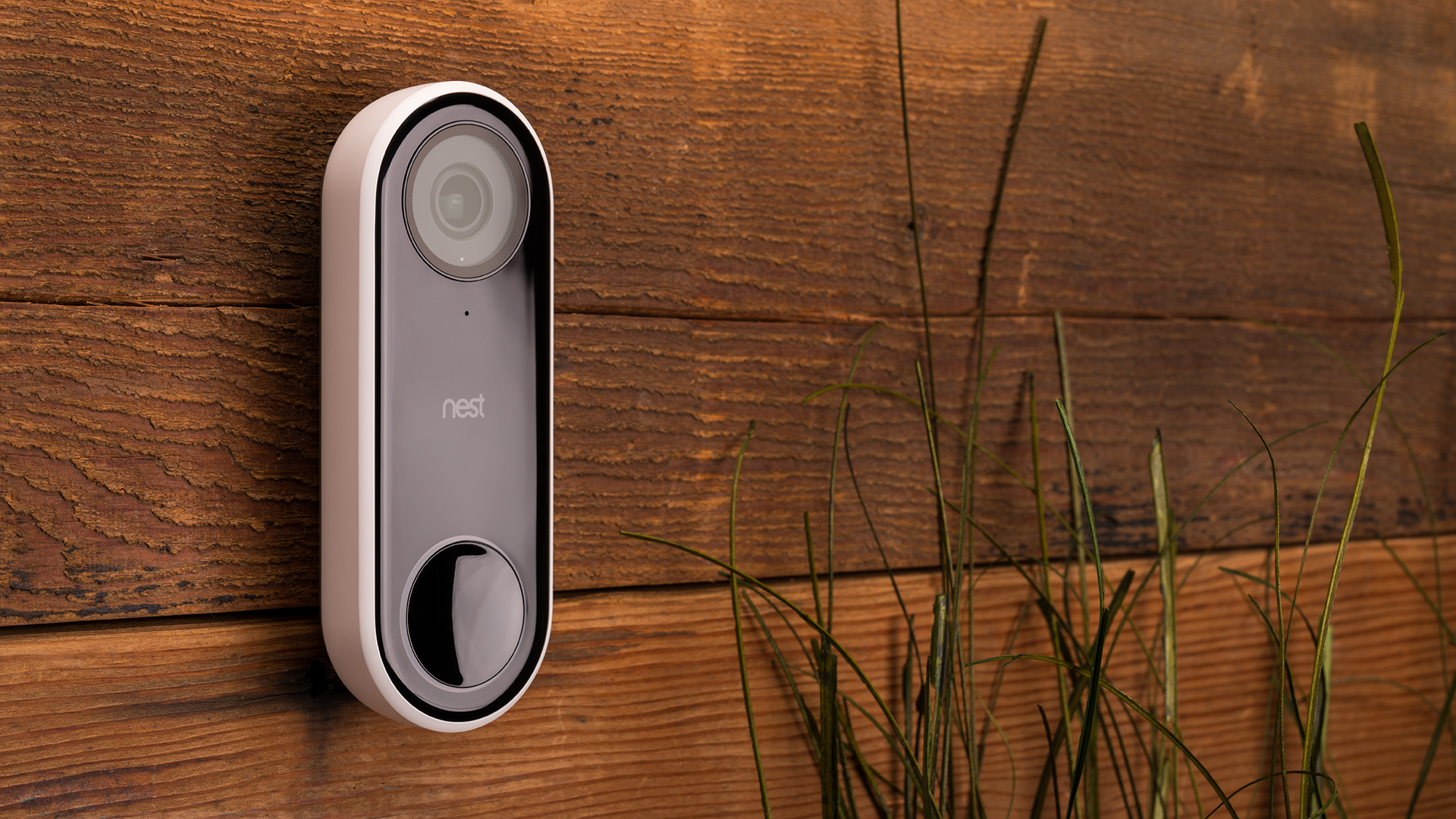
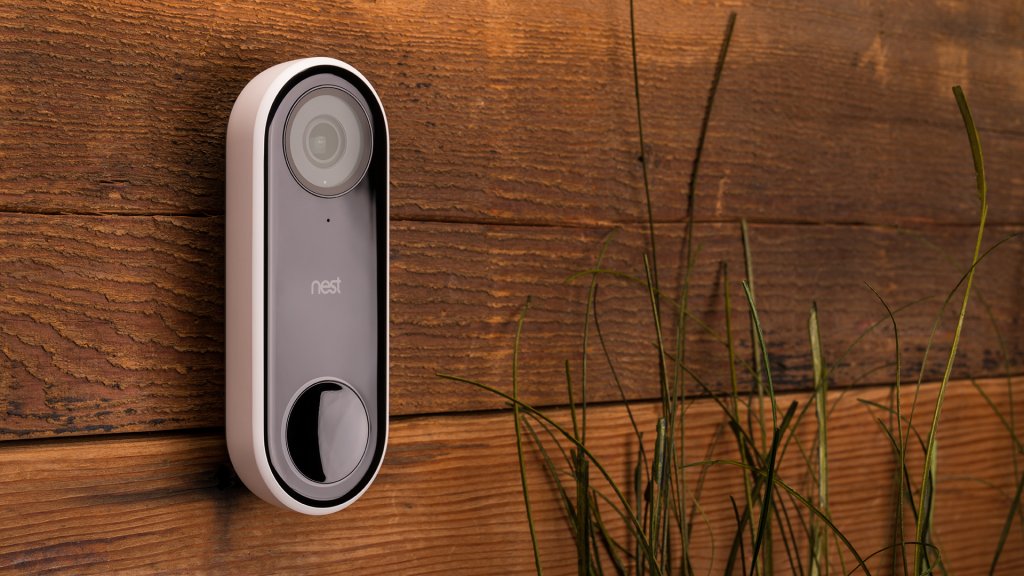
It’s no secret that two of the world’s biggest tech companies, Google and Amazon, are at odds with one another in the Smart Home space. They are the brands behind the two voice assistants that are shaping the way we interact with tech in our homes, and that makes them natural enemies.
However, the competition between the two behemoths goes much deeper than battle between Google Assistant and Amazon Alexa; since Amazon owns Ring and Google owns Nest, they are locked in a race for who will own more real estate in the world’s Smart Home security lineup.
Both companies have smart cameras in various forms and alarm systems, but Ring’s hallmark claim to fame has been their development of the smart video doorbell. Now in their 5th generation of smart doorbells, they have labored to stand above the pretenders who have come after them to remain at the top of the video doorbell game. The Nest Hello may have just flipped the script on that as Nest’s first dip into the crowded smart doorbell waters.
A Bird’s Eye View from the Nest
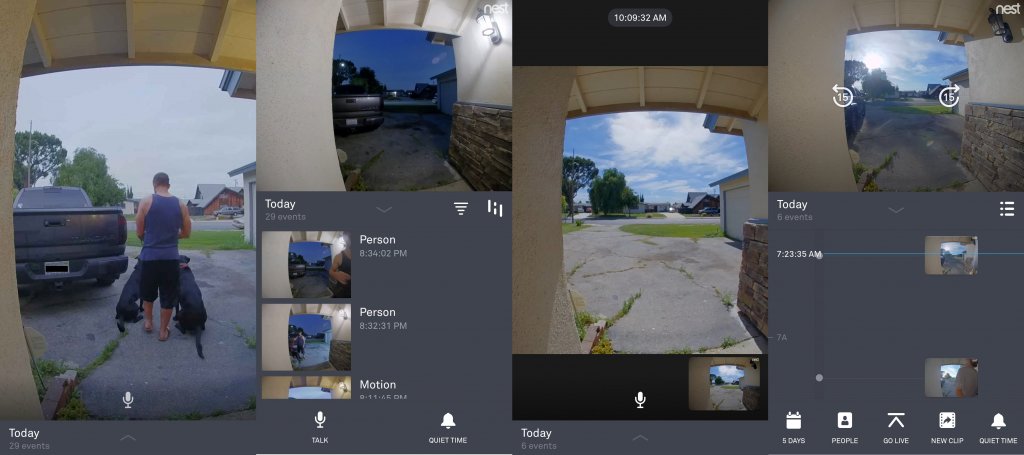
Right from the jump, my expectations were high for the Nest Hello. After coming to market with several smart cameras they should have the optics portion of the equation handled, while their expertise in design and device functionality set the bar for success high.
Powering the Nest Hello optics is a ⅓-inch, 3MP (2K) color sensor with HDR for crisp visuals and vibrant color in light and dark settings, which is probable in most doorbell placements. A 160° diagonal field of view (FOV) and 4:3 ratio capture head-to-toe visuals of visitors from any direction, without distortion.
Arguably one of the most important elements to the video doorbell features list is the resolution, and the Nest Hello puts out 1600×1200 at 30fps (frames per second) to deliver sharp detail and smooth motion in video recordings. When the sun sets and natural light is not present, eight IR (infrared) LEDs kick in to illuminate the field of view for night vision, and an 8x digital zoom is available in live view or when watching video recordings. As with most video doorbells, 24/7 live view streaming is available
How Nest Says Hello
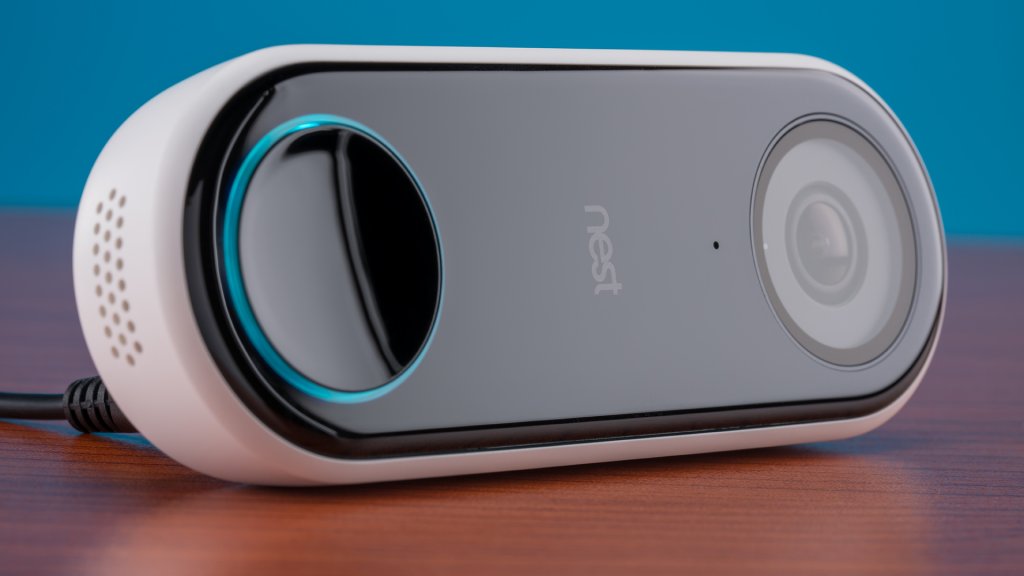
From an aesthetics perspective, the Nest Hello won my heart from the jump. The compact doorbell measures only 4.6” x 1.7” x 1” with the contrasting white body and polished piano black face making for an ultra-clean presentation. On the front of the unit, the camera lens up top is balanced by a doorbell button of equal size on the bottom, encircled with a vibrant LED ring that pulses pale white until it detects motion, then brightening or turning green when rung.
Aside from the pretty face, the Hello has an IPX4 waterproof construction which means splashing water from any direction via rain, sprinklers, or otherwise, should be no trouble to normal operation. Speaking of weather, the Hello can operate between 5°-104° F with 10%-80% relative humidity. Since there are certainly parts of the USA that get outside those ranges, I would have to imagine there is a slight buffer built in as well to account for normal operation in the winter and summer months (a few days into testing it reached 108° F and there were no issues).
Out of the box, the Nest Hello comes with all the necessary materials to install the doorbell, from the chime connector to the mounting plate and 15° wedge mount for those who want to angle the doorbell, to even a Nest masonry bit. Installation is straightforward with step-by-step instructions in the app, while Dual-Band connectivity to the home network and 128-bit AES with TLS/SSL encryption keep the information flowing smoothly and securely.
When someone rings the doorbell, in addition to receiving a push notification and the ability to tap into a live audio/video feed, users can enable pre-recorded quick responses to play when someone rings the doorbell. The microphone and speaker work in conjunction for HD speaking and listening, with noise and echo cancellation built-in.
Beyond the overt action of someone ringing the doorbell, video recording and alerts can be triggered based on person, motion, or sound detection. The Nest Hello also has the ability to identify friends and family with special facial recognition and AI alerts, with a Nest Aware subscription. More on that later.
Nest Hello: The Best Smart Video Doorbell of 2019?
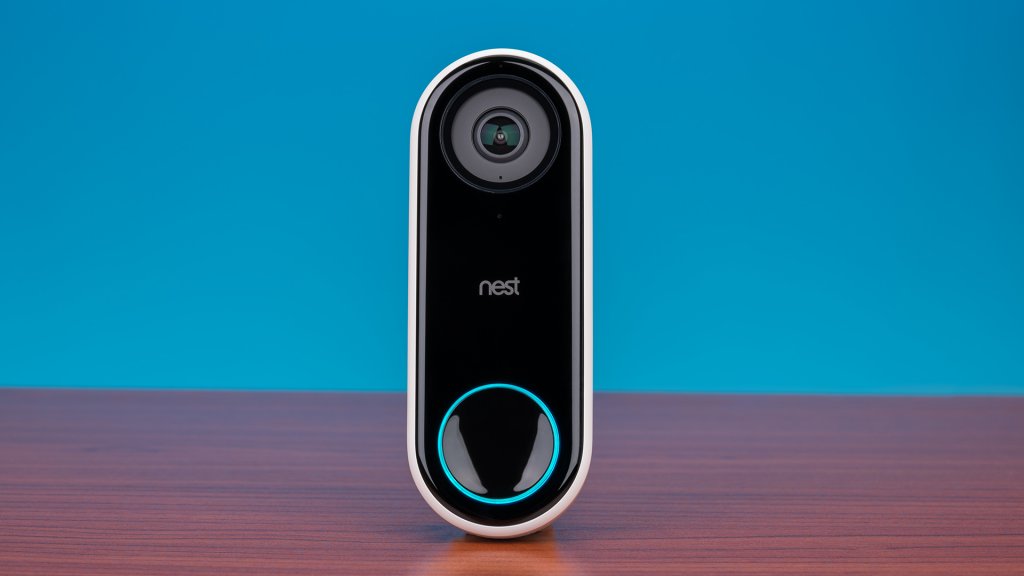
In terms of video quality, the Nest Hello is at the top of the pack, and I found that it had hands down the best visuals I’ve seen on a smart doorbell yet. It outperformed any other smart doorbell I have used before in a battery of lighting scenarios. With optimal lighting (mid-day, indirect) it was as detailed and crisp as expected, but the HDR really makes an impact when looking at the shadowed areas of the same image and seeing perfect clarity in both light and dark spaces. Even with someone approaching the door from bright sunlight to the shaded porch, facial details never were lost in the transition which impressed me quite a bit.
In lower light settings like dusk, the dead of night, or with direct sunlight on the lens, the camera adapted amazingly. No matter which scenario the Hello was in, it was able to show both ends of the illumination spectrum in full color and detail, without washouts from light or dark areas from extreme low light. All in all, I was extremely pleased with the visuals I got from this doorbell.
Speaking to the actual resolution, when zooming in to the maximum 8x power there is naturally a loss of some detail, but even then I found more clarity in the fine elements than anticipated.
Two Ears, One Mic
Switching gears over to the audio side of the spectrum, the Nest Hello continued to impress. The microphone was able to pick up clear detail from both triggered video clips and in-call from someone ringing the doorbell with sharp precision, without a lot of background noise and zero echo. Considering my entryway is enclosed on three sides this is no small feat. I could still hear passing cars, but they were noticeably muted compared to an unchecked audio broadcast.
When having a normal conversation with someone, one of the highlights was just that — a normal conversation. That means two people can speak without having to pause for several seconds and taking turns, like communicating via walkie talkie. At first, I almost didn’t even realize anything out of the ordinary because it felt just like chatting on the phone, but then it struck me how fluid and organic the interaction was. Not only was it fluid to speak, but with one press on the “Talk” button locked the microphone open so I could speak without having to press and hold each time, then release in order to hear the other party say their piece.
Aside from the motion-triggered alerts there is also the option to enable sound alerts. I found that they are triggered by normal-volume things like cars, footsteps, or conversations as well as loud noises. Sometimes these are combined with other motion or person alerts, but when a sound is detected in close range without a motion or person detected there will be a unique “Sound Detected” alert.
Integration in the Smart Home
Many people by now have at least one voice controller in their home, and Nest Hello can do some neat things with those too. The most intuitive integration for the Hello (or any Nest product) is with Google Assistant. Using any Google Home device (Google Home Mini, Google Home Hub, Google Home Max), users can enable a cool little feature called “Visitor Announcements”.
With this feature enabled, your Google Home announces visitors by name if they are stored as familiar faces in the app, or pipes off a generic “Someone is at the door.” if they are unfamiliar.
If you have a 3rd generation Google Chromecast, you can command Google Assistant to cast the live view feed from the Nest Hello (or any Nest camera) to the TV for viewing. When the video is cast to the TV, it adjusts to 16:9 ratio to fill out the screen from the natural 4:3, which is a pretty neat little feature as well.
Now, just because Google and Amazon are in a beef doesn’t mean that users who have an Amazon Echo device cannot use Alexa to control their Nest Hello. They can. In fact, anyone with an Alexa video device like an Amazon Echo Show or Amazon Echo Spot can display a live video feed on their device using the Nest Camera skill. Fortunately, for those who don’t have (or want) one of the Echo video devices, the live view from the Nest Hello can be cast to the TV with any generation Amazon Fire TV, second generation and later of Fire TV Stick, Fire TV Edition smart TVs, or seventh-generation and later Amazon Fire Tablets.
The Nest Hello has an MSRP of $199, but can often be found for up to $40 off that price. Factor in the Nest ecosystem that the doorbell is compatible with, and you’ve got a stellar device.
So is the Nest Hello the best smart video doorbell of 2019? My vote is a hard “Yes”.
Nest Aware
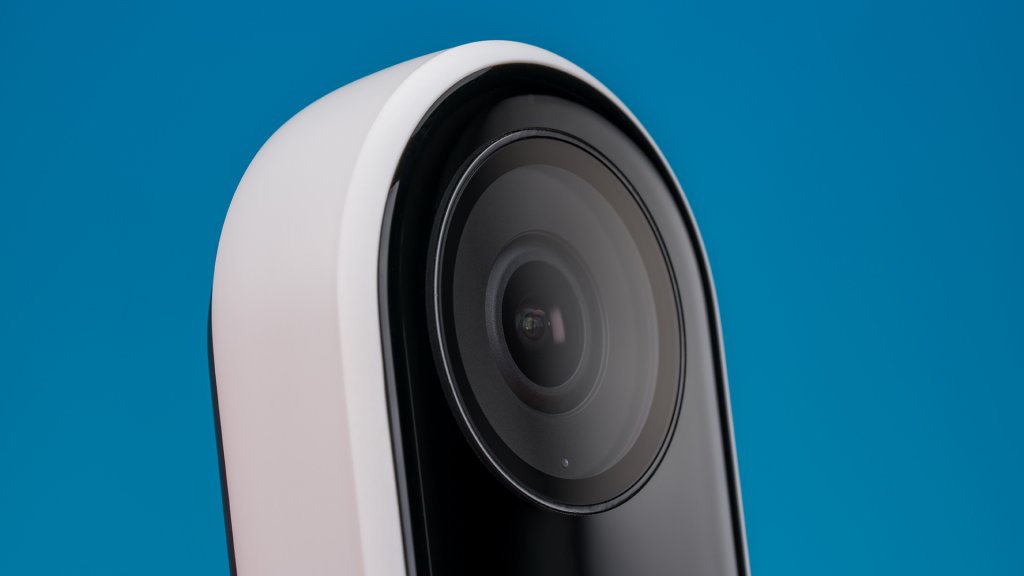
With that all being said, before I face the wrath of angry fanboys from every nook and cranny of the smart doorbell universe, that claim does have a stipulation attached to it. Some of the features that make the Nest Hello the super doorbell that it is require the Nest Aware subscription to access.
One of said features is continuous recording 24/7, so you can look at any point in time with or without a motion/person alert and before motion detection is triggered for the timeframe. Beyond the simple cool factor in rewinding or fast-forwarding time at-will, Nest Aware allows you to see what is going on before and after the sensors are tripped, along with creating clips to share and creating timelapse videos.
Also available with Nest Aware and the Nest Hello are Activity Zones, where users can specify certain areas of the video feed to be sensitive to motion, while others can be ignored. Now, I do think that this should be included with the base device functionality, since many other smart doorbells that are inferior don’t hide this feature behind a paywall, but that is where it is.
With “Closeups”, Nest Hello automatically zooms in on the action point within the video feed, to give a better view of what is happening out of the gate, however the smartest feature is “Familiar Faces,” which we will get to in a bit.
Nest Aware is offered as a tiered subscription $5/month for five-day video history, $10/month for 10-day video history, and $30/month for 30-day video history.
I will say that without subscribing to Nest Aware, there are a couple things that are a bit on the annoying side with the app.
Reminders about the “Free 30-day video storage with Nest Aware subscription” pop up every time you open the app, and it does get annoying. Even with the included 30-day gratis trial of Nest Aware that comes standard, the message still surfaces all the time. It disappears after a few seconds, so this can be overlooked.
Nest AI – Smart Home Security with Facial Recognition
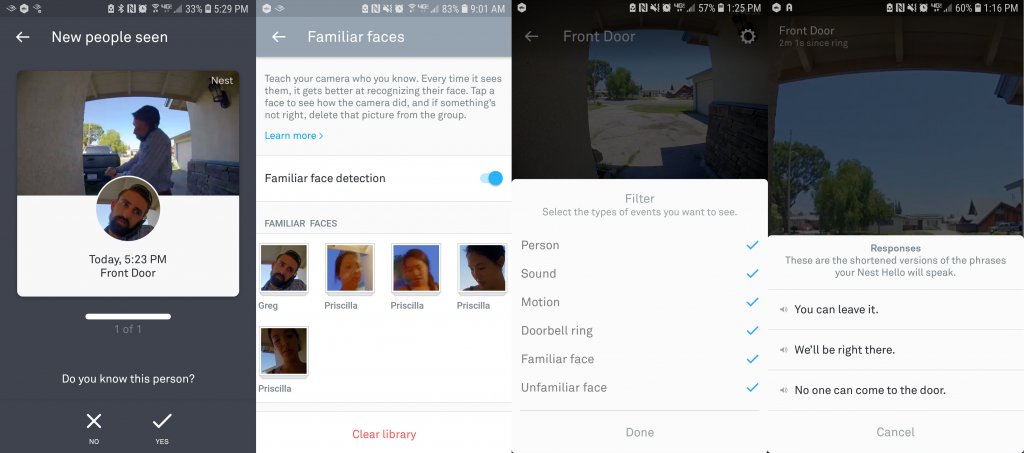
When leveraging the “Motion” and “Person” alert triggers, the identification between object motion and people was never off, which was pretty impressive. Other smart video doorbells that I’ve used sometimes classified a person as a “motion”, but the Nest Hello didn’t miss a beat.
“Familiar Faces” (with Nest Aware) is a facial recognition algorithm which can send an alert if an unknown face is detected. This can also be used for their Nest IQ indoor or outdoor cameras for other areas of the home. When the unfamiliar face is detected the app takes at least one, but sometimes upwards of seven photos of the person’s face and asks if you want to classify them. When you add someone to the log, it will alert you via push notification if the person it detected is friend or unknown.
Also, Google Assistant can announce the person by name if they are stored in Familiar Faces and Visitor Announcements are turned on. In practice, this worked very well. Without a person identified, Google Home would announce that someone was at the door when the doorbell rings, and if the person is identified in the app it would announce them by name.
You can select which Google Home devices broadcast this message within the Google Home app, so if you have several Google Homes it does not have to blare the message throughout the entire property.
Buy the Nest Hello Wi-Fi video doorbell- $184.00
Automating Your Whole Home with the Nest Connected Ecosystem
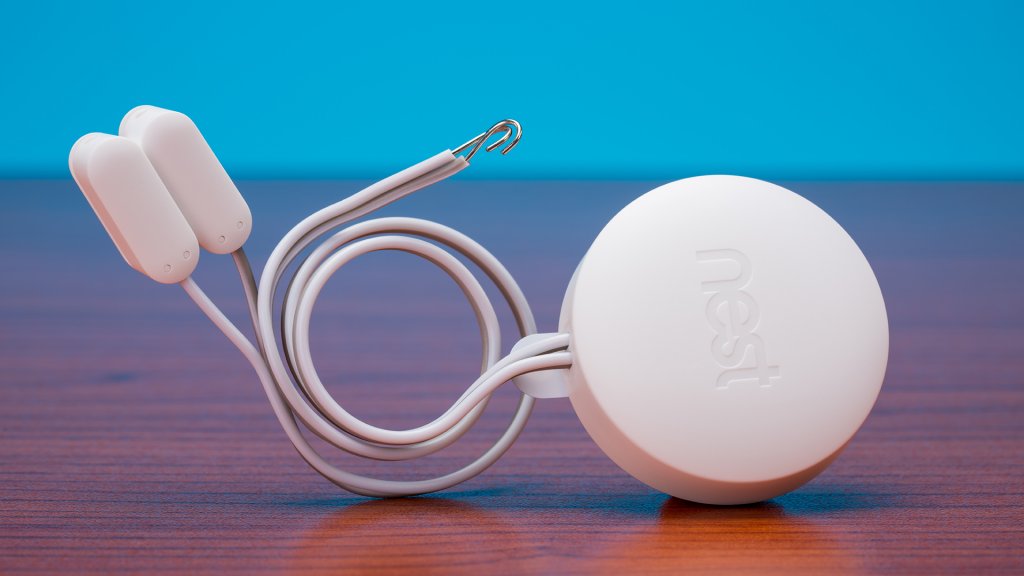
The Nest ecosystem is quite expansive, spread across several segments of the Smart Home landscape. The Nest Hello video doorbell, Nest IQ Cams, Nest thermostats, Nest Secure alarm, Nest x Yale lock, and Nest Detect sensors all work together for a connected home ecosystem with their “Home/Away” assist.
What this means is that when the geolocation or manual input (depending on the device) detects that someone is home, certain actions can automatically occur. For example, when a Nest x Yale lock is unlocked, it can disengage the Nest Secure alarm, deactivate other cameras, or customizing the timing for the door to lock by itself after detecting someone has come home.
There are a variety of manners in which this can be used, but at the end of the day Nest is building out a comprehensive ecosystem of devices that touches various segments of the home, aimed at automating life.
One thing that would be great for Nest to implement, which they are still lagging behind Ring with, is a community events site. The Ring Neighbors app is a community-based communication app that allows anyone, whether or not you own a Ring product, to view submitted footage from Ring smart cameras and video doorbells. Essentially, this is a neighborhood watch ramped up with technology and beyond just a very targeted area.
Law enforcement actually can use the app to submit updates and alerts to keep people more aware of what is going on in their community. Really, this is pretty groundbreaking. Local news isn’t as granular as your very neighborhood, nor as up-to-date. Facebook groups don’t have the visual evidence that this app has, and it likely doesn’t have the same support or real-time crime and safety alerts. This is a really great tool for keeping people aware of what is going on in their area, and making sure they are alert. Situational awareness is always a critical component to staying safe, wherever you are.
One thing the Nest Hello does need an app update for is a motion detection sensitivity calibration. I’m actually surprised that this isn’t available already, since most smart floodlights and doorbells I’ve used so far give the option to increase or decrease sensitivity. The Hello is a victim of its own proficiency, and has no trouble detecting motion over 70ft from the device: resulting in a load of false motion alerts from cars passing on my street. Don’t get me wrong, I’m extremely impressed with the tech Nest has. It is possible in the app to specify whether or not motion will trigger the push notification alerts, or if only people, sounds, or doorbell rings trigger activity. However, I’d like to be able to get motion alerts for activity close range to my door, whether a human or not.
The Journey to the Top Starts with a First Step
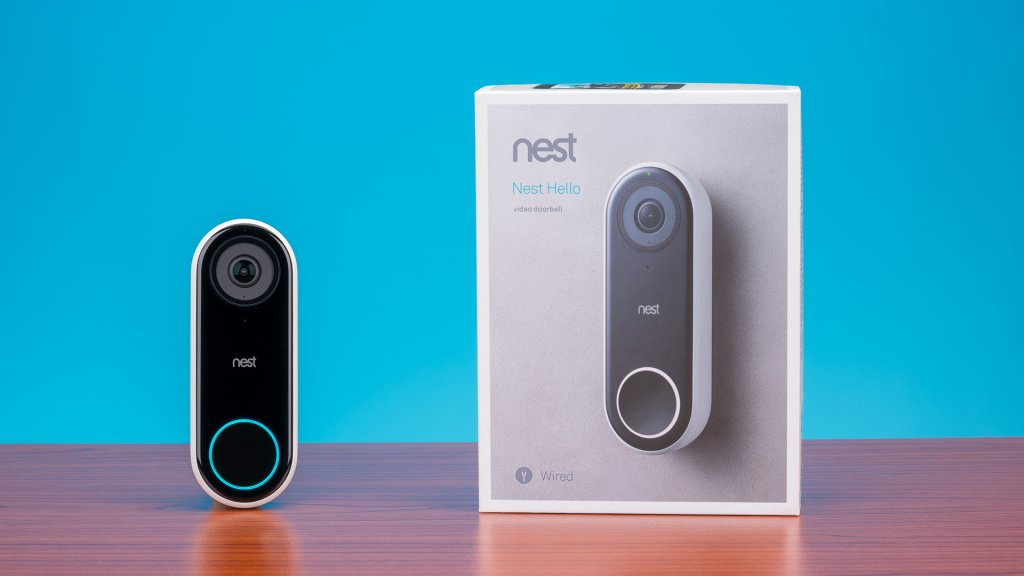
Despite some of my nitpicky complaints about the Nest Hello smart video doorbell, it is still a phenomenal product. From start to finish, the device is meticulously designed and executed for a truly polished product. Video and audio quality are superb, the AI is really top-notch, and the small touches to make the app more intuitive to use are appreciated. Especially considering this is the first Wi-Fi doorbell from Nest, they have knocked it out of the park and I’m eagerly anticipating the second version in the future.
Featured in this article:
Nest Hello Wi-Fi video doorbell- $184.00
Google Chromecast 3rd generation- $34.90
Note, all prices and products are accurate at the time of article publication, although some may have changed or are no longer available.

